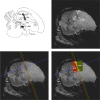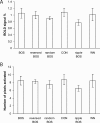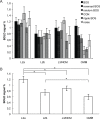Functional MRI of auditory responses in the zebra finch forebrain reveals a hierarchical organisation based on signal strength but not selectivity
- PMID: 18781203
- PMCID: PMC2527133
- DOI: 10.1371/journal.pone.0003184
Functional MRI of auditory responses in the zebra finch forebrain reveals a hierarchical organisation based on signal strength but not selectivity
Abstract
Background: Male songbirds learn their songs from an adult tutor when they are young. A network of brain nuclei known as the 'song system' is the likely neural substrate for sensorimotor learning and production of song, but the neural networks involved in processing the auditory feedback signals necessary for song learning and maintenance remain unknown. Determining which regions show preferential responsiveness to the bird's own song (BOS) is of great importance because neurons sensitive to self-generated vocalisations could mediate this auditory feedback process. Neurons in the song nuclei and in a secondary auditory area, the caudal medial mesopallium (CMM), show selective responses to the BOS. The aim of the present study is to investigate the emergence of BOS selectivity within the network of primary auditory sub-regions in the avian pallium.
Methods and findings: Using blood oxygen level-dependent (BOLD) fMRI, we investigated neural responsiveness to natural and manipulated self-generated vocalisations and compared the selectivity for BOS and conspecific song in different sub-regions of the thalamo-recipient area Field L. Zebra finch males were exposed to conspecific song, BOS and to synthetic variations on BOS that differed in spectro-temporal and/or modulation phase structure. We found significant differences in the strength of BOLD responses between regions L2a, L2b and CMM, but no inter-stimuli differences within regions. In particular, we have shown that the overall signal strength to song and synthetic variations thereof was different within two sub-regions of Field L2: zone L2a was significantly more activated compared to the adjacent sub-region L2b.
Conclusions: Based on our results we suggest that unlike nuclei in the song system, sub-regions in the primary auditory pallium do not show selectivity for the BOS, but appear to show different levels of activity with exposure to any sound according to their place in the auditory processing stream.
Conflict of interest statement
Figures






Similar articles
-
Neural representation of spectral and temporal features of song in the auditory forebrain of zebra finches as revealed by functional MRI.Eur J Neurosci. 2007 Nov;26(9):2613-26. doi: 10.1111/j.1460-9568.2007.05865.x. Epub 2007 Oct 23. Eur J Neurosci. 2007. PMID: 17970728 Free PMC article.
-
Development of selectivity for natural sounds in the songbird auditory forebrain.J Neurophysiol. 2007 May;97(5):3517-31. doi: 10.1152/jn.01066.2006. Epub 2007 Mar 14. J Neurophysiol. 2007. PMID: 17360830
-
Neural response to bird's own song and tutor song in the zebra finch field L and caudal mesopallium.J Comp Physiol A Neuroethol Sens Neural Behav Physiol. 2004 Jun;190(6):469-89. doi: 10.1007/s00359-004-0511-x. Epub 2004 Apr 3. J Comp Physiol A Neuroethol Sens Neural Behav Physiol. 2004. PMID: 15064966
-
Song selectivity in the song system and in the auditory forebrain.Ann N Y Acad Sci. 2004 Jun;1016:222-45. doi: 10.1196/annals.1298.023. Ann N Y Acad Sci. 2004. PMID: 15313778 Review.
-
Song- and order-selective neurons develop in the songbird anterior forebrain during vocal learning.J Neurobiol. 1997 Nov;33(5):694-709. J Neurobiol. 1997. PMID: 9369467 Review.
Cited by
-
Own-song recognition in the songbird auditory pathway: selectivity and lateralization.J Neurosci. 2009 Feb 18;29(7):2252-8. doi: 10.1523/JNEUROSCI.4650-08.2009. J Neurosci. 2009. PMID: 19228978 Free PMC article.
-
Tracing development of song memory with fMRI in zebra finches after a second tutoring experience.Commun Biol. 2023 Mar 30;6(1):345. doi: 10.1038/s42003-023-04724-2. Commun Biol. 2023. PMID: 36997617 Free PMC article.
-
Tracing the development of learned song preferences in the female zebra finch brain with functional magnetic resonance imaging.Dev Neurobiol. 2024 Apr;84(2):47-58. doi: 10.1002/dneu.22934. Epub 2024 Mar 11. Dev Neurobiol. 2024. PMID: 38466218 Free PMC article.
-
Birds, primates, and spoken language origins: behavioral phenotypes and neurobiological substrates.Front Evol Neurosci. 2012 Aug 16;4:12. doi: 10.3389/fnevo.2012.00012. eCollection 2012. Front Evol Neurosci. 2012. PMID: 22912615 Free PMC article.
-
Functional magnetic resonance imaging (FMRI) with auditory stimulation in songbirds.J Vis Exp. 2013 Jun 3;(76):4369. doi: 10.3791/4369. J Vis Exp. 2013. PMID: 23770665 Free PMC article.
References
-
- Doupe AJ, Kuhl PK. Birdsong and human speech: common themes and mechanisms. Annu Rev Neurosci. 1999;22:567–631. - PubMed
-
- Hauser MD, Chomsky N, Fitch WT. The faculty of language: What is it, who has it, and how did it evolve? Science. 2002;298:1569–1579. - PubMed
-
- Nowicki S, Searcy WA. Song function and the evolution of female preferences: why birds sing, why brains matter. Ann N Y Acad Sci. 2004;1016:704–723. - PubMed
-
- Konishi M. The role of auditory feedback in the control of vocalization in the white-crowned sparrow. Zeitsch Tierpsychol. 1965;22:770–783. - PubMed
-
- Price PH. Developmental determinants of structure in zebra finch song. J Comp Phys Psych. 1979;93:268–277.

